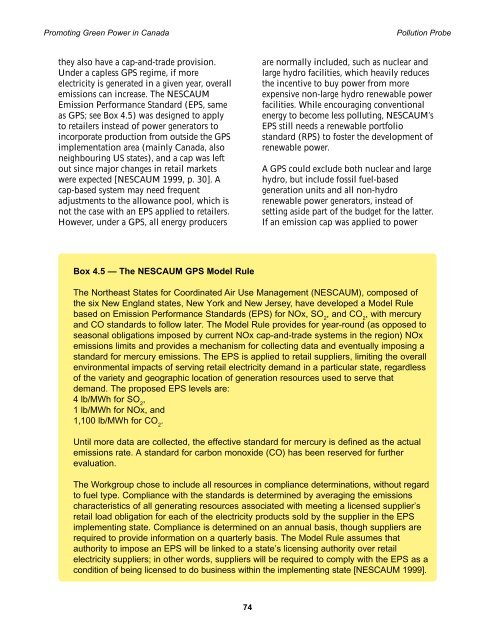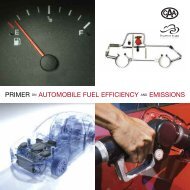<strong>Promot<strong>in</strong>g</strong> <strong>Green</strong> <strong>Power</strong> <strong>in</strong> <strong>Canada</strong> Pollution Probethey also have a cap-and-trade provision.Under a capless GPS regime, if moreelectricity is generated <strong>in</strong> a given year, overallemissions can <strong>in</strong>crease. The NESCAUMEmission Per<strong>for</strong>mance Standard (EPS, sameas GPS; see Box 4.5) was designed to applyto retailers <strong>in</strong>stead of power generators to<strong>in</strong>corporate production from outside the GPSimplementation area (ma<strong>in</strong>ly <strong>Canada</strong>, alsoneighbour<strong>in</strong>g US states), and a cap was leftout s<strong>in</strong>ce major changes <strong>in</strong> retail marketswere expected [NESCAUM 1999, p. 30]. Acap-based system may need frequentadjustments to the allowance pool, which isnot the case with an EPS applied to retailers.However, under a GPS, all energy producersare normally <strong>in</strong>cluded, such as nuclear andlarge hydro facilities, which heavily reducesthe <strong>in</strong>centive to buy power from moreexpensive non-large hydro renewable powerfacilities. While encourag<strong>in</strong>g conventionalenergy to become less pollut<strong>in</strong>g, NESCAUM’sEPS still needs a renewable portfoliostandard (RPS) to foster the development ofrenewable power.A GPS could exclude both nuclear and largehydro, but <strong>in</strong>clude fossil fuel-basedgeneration units and all non-hydrorenewable power generators, <strong>in</strong>stead ofsett<strong>in</strong>g aside part of the budget <strong>for</strong> the latter.If an emission cap was applied to powerBox 4.5 — The NESCAUM GPS Model RuleThe Northeast States <strong>for</strong> Coord<strong>in</strong>ated Air Use Management (NESCAUM), composed ofthe six New England states, New York and New Jersey, have developed a Model Rulebased on Emission Per<strong>for</strong>mance Standards (EPS) <strong>for</strong> NOx, SO 2, and CO 2, with mercuryand CO standards to follow later. The Model Rule provides <strong>for</strong> year-round (as opposed toseasonal obligations imposed by current NOx cap-and-trade systems <strong>in</strong> the region) NOxemissions limits and provides a mechanism <strong>for</strong> collect<strong>in</strong>g data and eventually impos<strong>in</strong>g astandard <strong>for</strong> mercury emissions. The EPS is applied to retail suppliers, limit<strong>in</strong>g the overallenvironmental impacts of serv<strong>in</strong>g retail electricity demand <strong>in</strong> a particular state, regardlessof the variety and geographic location of generation resources used to serve thatdemand. The proposed EPS levels are:4 lb/MWh <strong>for</strong> SO 2,1 lb/MWh <strong>for</strong> NOx, and1,100 lb/MWh <strong>for</strong> CO 2.Until more data are collected, the effective standard <strong>for</strong> mercury is def<strong>in</strong>ed as the actualemissions rate. A standard <strong>for</strong> carbon monoxide (CO) has been reserved <strong>for</strong> furtherevaluation.The Workgroup chose to <strong>in</strong>clude all resources <strong>in</strong> compliance determ<strong>in</strong>ations, without regardto fuel type. Compliance with the standards is determ<strong>in</strong>ed by averag<strong>in</strong>g the emissionscharacteristics of all generat<strong>in</strong>g resources associated with meet<strong>in</strong>g a licensed supplier’sretail load obligation <strong>for</strong> each of the electricity products sold by the supplier <strong>in</strong> the EPSimplement<strong>in</strong>g state. Compliance is determ<strong>in</strong>ed on an annual basis, though suppliers arerequired to provide <strong>in</strong><strong>for</strong>mation on a quarterly basis. The Model Rule assumes thatauthority to impose an EPS will be l<strong>in</strong>ked to a state’s licens<strong>in</strong>g authority over retailelectricity suppliers; <strong>in</strong> other words, suppliers will be required to comply with the EPS as acondition of be<strong>in</strong>g licensed to do bus<strong>in</strong>ess with<strong>in</strong> the implement<strong>in</strong>g state [NESCAUM 1999].74
<strong>Promot<strong>in</strong>g</strong> <strong>Green</strong> <strong>Power</strong> <strong>in</strong> <strong>Canada</strong> Pollution Probeproducers, then such a system would leavefossil fuel-based generators the options ofeither us<strong>in</strong>g abatement technologies or buy<strong>in</strong>gelectricity from renewable power providers,exclud<strong>in</strong>g large hydro and nuclear. At the endof each year, f<strong>in</strong>es would have to be paid <strong>for</strong>excess emissions. These f<strong>in</strong>es should be highenough to exceed the production cost <strong>for</strong>renewable power; that is, they should allowproviders to obta<strong>in</strong> a premium. Theadm<strong>in</strong>istrator allocates allowances based onelectricity production <strong>in</strong> a given year, withallocation be<strong>in</strong>g adjusted each year depend<strong>in</strong>gon actual changes <strong>in</strong> generation patterns. AGPS with cap-and-trade has virtually thesame outcome as a set-aside that is undersubscribed,with unused allowances be<strong>in</strong>gredistributed to emitt<strong>in</strong>g units.An additional benefit of the GPS with capand trade is that, as the allocation ofallowances is reassessed each year based onactual output, low-emission units areencouraged to <strong>in</strong>crease their production asthey then can sell off surplus allowancesga<strong>in</strong>ed through their below-average emissions.No allowances should be allocated to largehydro and nuclear facilities as this would leadto a much higher cost <strong>for</strong> fossil fuel-basedgeneration, which would <strong>in</strong> turn causeelectricity prices to <strong>in</strong>crease more than<strong>in</strong>tended 19 [RFF 2002, p. 15].4.2.2 Mandatory Offset Trad<strong>in</strong>gThe first offset trad<strong>in</strong>g markets came <strong>in</strong>toexistence <strong>in</strong> the United States under the NewSource Review provisions of the 1990 CleanAir Act Amendments, <strong>in</strong> order to allow <strong>for</strong>new emission sources to come on-l<strong>in</strong>e <strong>in</strong> nonatta<strong>in</strong>mentareas (areas that do not achievenational ambient air quality standards). Themarket <strong>for</strong> offset credits is much less activethan some of the other emissions trad<strong>in</strong>gprograms <strong>in</strong> operation — the adm<strong>in</strong>istrativeprocess is cumbersome and transaction costsare generally quite high. In addition, theprocess of creat<strong>in</strong>g an offset is complex andtime consum<strong>in</strong>g and requires a substantialSet-asides can be seen as a specialcase of a GPS, equipped with a capand-tradefeature and a slightlydifferent mechanism to allocateallowances to renewables.<strong>in</strong>itial cash outlay to complete an emissionreduction project be<strong>for</strong>e the credits are created.For a source that wishes to rely on offset creditsas a revenue stream to fund such a project, theprocess can be frustrat<strong>in</strong>gly backwards [NWCC2001a, p. 64]. At present, these programs donot allow renewables to participate.CO 2offset trad<strong>in</strong>g is be<strong>in</strong>g implemented <strong>in</strong>an <strong>in</strong>creas<strong>in</strong>g number of states, despite theUS government’s refusal to ratify the KyotoProtocol. The Oregon Climate Trust wasdeveloped as a result of a groundbreak<strong>in</strong>glaw enacted by the State of Oregon <strong>in</strong> 1997.House Bill 3283 is the first state-levellegislation to create a mean<strong>in</strong>gful measure tocontrol carbon dioxide emissions. The Billrequires all new energy facilities built <strong>in</strong> thestate to implement measures to avoid, displaceor sequester a portion of their carbon dioxideemissions <strong>in</strong> an amount equal to 17% lesscarbon dioxide than the least-pollut<strong>in</strong>g plantoperat<strong>in</strong>g <strong>in</strong> the US (<strong>for</strong> gas-fired plants).New plant developers may choose to meetthis obligation by contribut<strong>in</strong>g funds to aqualified nonprofit organization that, <strong>in</strong> turn,<strong>in</strong>vests <strong>in</strong> carbon reduction or sequestrationprojects [NWCC 2001a, p. 84]. Offsets weretraded at prices between (US) $1.50 and$4.50 <strong>in</strong> 2001, depend<strong>in</strong>g on the nature ofthe project [TCT 2002]. New Jersey and NewHampshire have also developed strategies toimplement mandatory CO 2cap and tradeprograms. As recently as June 2002, a reportby the Commission <strong>for</strong> EnvironmentalCooperation recommended the <strong>in</strong>troductionof a NAFTA-wide carbon trad<strong>in</strong>g regime [CEC2002d, p. 32]. Ontario’s Select Committee onAlternative Fuel Sources has recommendedthe <strong>in</strong>troduction of carbon trad<strong>in</strong>g by July 1,75
















